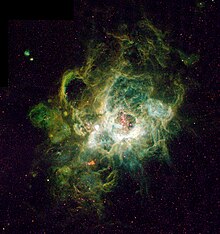Nebula

A nebula (Latin: "mist"; pl. nebulae or nebulæ, with ligature; from Greek nephele, "cloud") is an interstellar cloud of dust, gas and plasma. Originally nebula was a general name for any extended astronomical object, including galaxies beyond the Milky Way (some examples of the older usage survive; for example, the Andromeda Galaxy is sometimes referred to as the Andromeda Nebula).
Astrophysics of nebulae
Nebulae are the birthplace of stars. They are formed when very diffused molecular clouds begin to collapse under their own gravity, often due to the influence of a nearby supernova explosion. The cloud collapses and fragments, sometimes forming hundreds of new stars. The newly-formed stars ionize the surrounding gas to produce an emission nebula.
Other nebulae are formed by the death of stars; a star that undergoes the transition to a white dwarf blows off its outer layer to form a planetary nebula. Novae and supernovae can also create nebulae known as nova remnants and supernova remnants, respectively.
